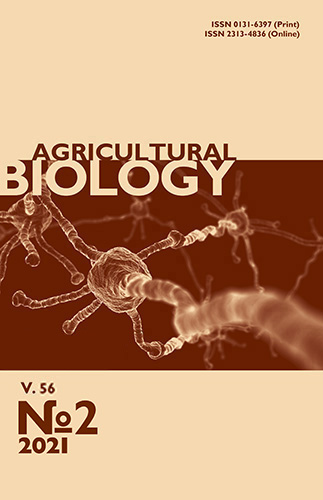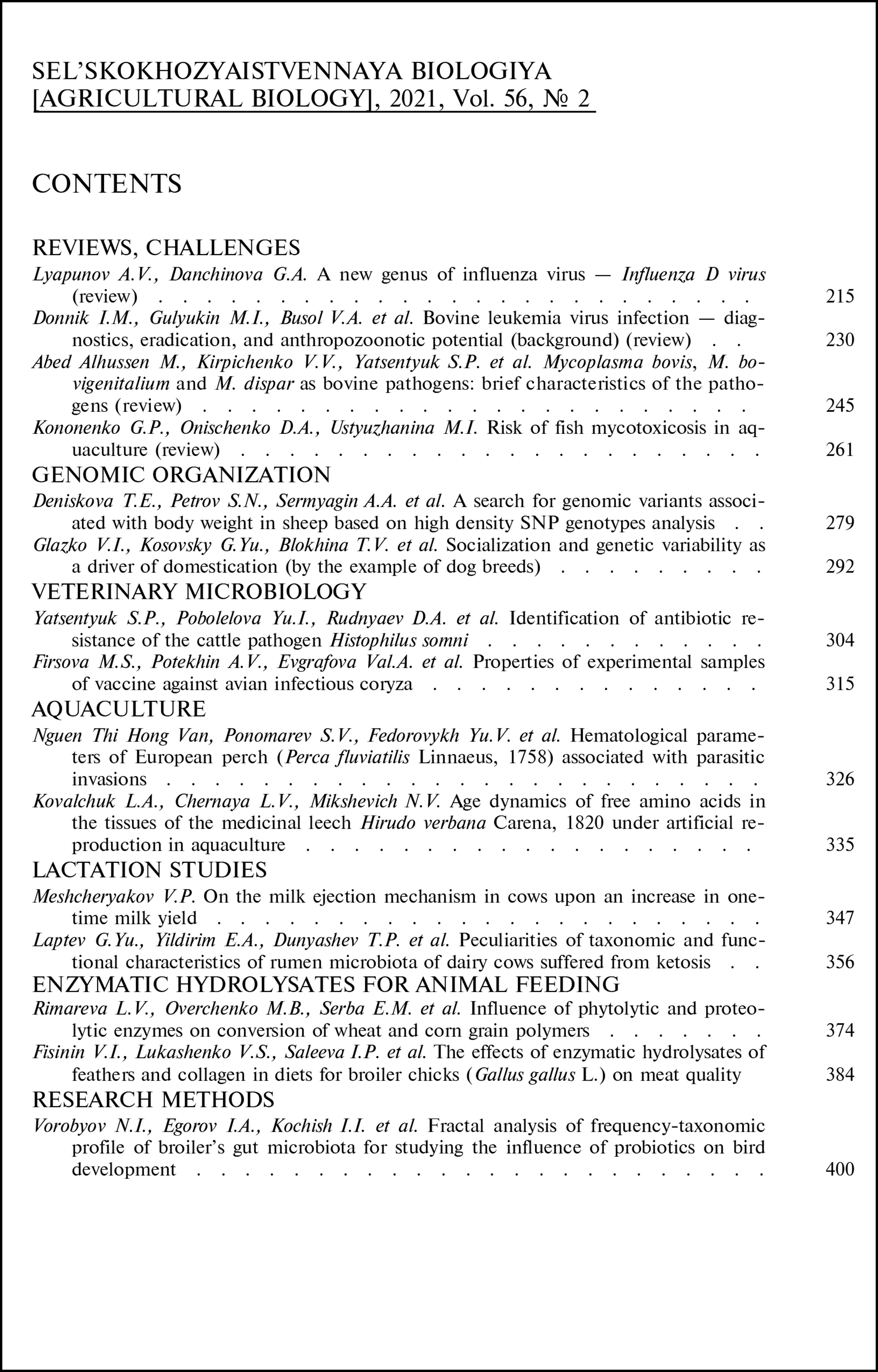doi: 10.15389/agrobiology.2021.2.374eng
UDC: 633.1:577.15
Acknowledgements:
The studies were carried out at the expense of the subsidy for the fulfillment of the state task within the framework of the Fundamental Scientific Research Program of the State Academies of Sciences (topic No. 0529-2019-0066).
INFLUENCE OF PHYTOLYTIC AND PROTEOLYTIC ENZYMES ON CONVERSION OF WHEAT AND CORN GRAIN POLYMERS
L.V. Rimareva, M.B. Overchenko, E.M. Serba ✉, N.I. Ignatova,
N.V. Shelekhova
All-Russin Research Institute of Food Biotechnology — a Branch of Federal Research Center for Nutrition, Biotechnology and Food Safety, 4b, ul. Samokatnaya, Moscow, 111033 Russia, е-mail serbae@mail.ru (✉ corresponding author), lrimareva@mail.ru, mb_over@mail.ru,
ignatova59@list.ru, satella@mail.ru , georg-laptev@rambler.ru, georg-laptev@rambler.ru
ORCID:
Rimareva L.V. orcid.org/0000-0003-3097-0836
Ignatova N.I. orcid.org/0000-0002-8416-7478
Overchenko M.B. orcid.org/0000-0003-0191-5897
Shelekhova N.V. orcid.org/0000-0001-7735-2942
Serba E.M. orcid.org/0000-0002-1660-2634
Received July 13, 2020
Grain, in addition to starch, hemicelluloses and protein, is known to be phytic acid and its salts. It has been shown that the use of phytolytic enzymes promotes the release of phosphorus, improves the digestibility of feed nutrients and increases the meat productivity of livestock and poultry. However, the catalytic effect of phytases and their combinations with proteases on degradation of polysaccharides and protein polymers in grain raw materials, on the release of cations and anions, especially in grain wort for the production of alcohol, has been little studied. This work shows for the first time that phytolytic enzymes improve qualitative estimates, rheological properties and change the ionic composition of grain wort by not only releasing phosphates and metal cations, but also by increasing the concentration of organic salt anions. The combined action of phytolytic and proteolytic enzymes on polymers of grain raw materials provides their catalytic degradation to soluble carbohydrates, nitrogenous substances, cations and anions to produce the enriched grain wort. This work aimed to assess the degree of phytolytic and proteolytic conversion of high-molecular-weight polymers in grain wort. For grain wort, 50 g portions of wheat (Triticum sp.) or corn (Zea mays) grain flour put into Erlenmeyer flasks were added with 150 cm3 of water and incubated in a water bath. At grain batching for starch dextrinization, a thermo-stable a-amylase was added (0.6 units/g starch). For starch conversion to sugars and hydrolysis of non-starch polysaccharides in the control, we used glucoamylase (9.0 units/g starch) and xylanase (0.15 units/g raw material). Phytase (from 1.0 to 2.5 units/g raw material) and a proteolytic enzyme preparation (0.1 units/g raw material) were also added. The control was added neither with phytase, nor the proteolytic enzyme. The profiles of the main polymers of grain raw materials, the grain wort concentration, the content of reducing carbohydrates (RС) were determined according to the techno-chemical instructions for the control of alcohol production, the amine nitrogen (NH2+) concentration was measured by a method based on the ability of amino acids to form soluble copper compounds with a suspension of copper phosphate. The dynamic viscosity of the grain wort was evaluated by vibrational viscometry. The study of the ionic composition of the grain mix and wort was carried out using a PrinCE-560 series capillary electrophoresis system (PrinCE Technologies B.V., Netherlands) equipped with a conductometric detector. The optimal dosage of phytase was 1.5 units/g raw material which ensures the maximum release of ions identified by capillary electrophoresis and the effective conversion of polysaccharides, protein and phytin substances of the grain. It was found that the phytolytic enzymes contributed to a decrease in the viscosity of wheat and corn wort of more than 20 %, a 9.5-11.3 % increase in the concentration of reducing carbohydrates, and a 2.1-2.4-fold increase in the concentrations of released ions. The concentration of amino nitrogen in the wort did not change significantly. It was shown that as a result of the phytolytic action, the concentration of not only metal phosphates and cations, but also anions of organic salts, such as oxalates, malates, citrates, and succinates (in wheat wort) and oxalates, malates, citrates, and lactates (in corn wort) increased. A more significant effect of phytase for corn wort was revealed: the concentration of phosphates in the nutrient medium increased 3.9 times vs. 1.6 times for wheat wort, the levels of potassium and magnesium ions were 12 % and 22 % higher, respectively, as compared to the control in which the phytase was not used. The optimal composition of the enzyme complex is proposed which ensures the effective hydrolysis of polysaccharides, phytin and protein substances of processed raw materials. The synergistic effect of phytolytic and proteolytic enzymes enhances the catalytic hydrolysis of high molecular weight polymers of plant origin and enriches the grain wort with carbohydrates, nitrogenous substances, phosphates, and minerals in bioavailable form. Biocatalytic treatment of grain with the developed enzyme complex which, along with amylases and xylanase, contains phytase and proteases, provides a 16.8 % and 18.8 % increase in the concentration of reducing carbohydrates in wheat and corn wort, a 1.7- and 1.9-fold increase in amine nitrogen and a decrease in wort viscosity by 41.7 % and 44.7 %, respectively.
Keywords: phytase, protease, wheat raw material, corn raw material, biocatalysis, ions, cations, phosphorus, grain wort.
REFERENCES
- Krivchenko V.A., Turshatov M.V., Solov'ev A.O., Abramova I.M. Pishchevaya promyshlennost', 2019, 4: 53-54 CrossRef (in Russ.).
- Stepanov V.I., Ivanov V.V., Sharikov A.Yu., Amelyakina M.V., Polivanovskaya D.V., Serba E.M. Pishchevaya promyshlennost', 2019, 4: 101-102 CrossRef (in Russ.).
- Ronghou L., Fei S. Impacts of main factors on bioethanol fermentation from stalk juice of sweet sorghum by immobilized Saccharomyces cerevisiae (CICC 1308). Bioresource Technology, 2008, 99(4): 847-854 CrossRef
- Serba E.M., Abramova I.M., Rimareva L.V., Overchenko M.B., Ignatova N.I., Grunin E.A. Pivo i napitki, 2018, 1: 50-54 CrossRef (in Russ.).
- Du Y., Shi P., Huang H., Zhang X., Luo H., Wang Y., Yao B. Characterization of three novel thermophilic xylanases from Humicola insolens Y1 with application potentials in the brewing industry. Bioresource Technology, 2013, 130: 161-167 CrossRef
- Vinetsky Y.P., Rozhkova A.M., Sereda A.S., Tsurikova N.V., Nurtaeva A.K., Semenova M.V., Zorov I.N., Sinitsyn A.P. Increase in glucoamylase productivity of Aspergillus awamori strain by combination of radiation mutagenesis and plasmid transformation methods. Applied Biochemistry and Microbiology, 2010, 46(6): 633-640 CrossRef
- Benešová K., Běláková S., Mikulíková R., Svoboda Z. Survey of the analytical methods for the phytic acid determination. Kvasny Prumysl, 2013, 59(5): 127-133 CrossRef
- Mikulski D., Kłosowski G. Phytic acid concentration in selected raw materials and analysis of its hydrolysis rate with the use of microbial phytases during the mashing process. Journal of the Institute of Brewing, 2015, 121(2): 213-218 CrossRef
- De Carli L., Schnitzler E., Ionashiro M., Szpoganicz B., Rosso N.D. Equilibrium, thermoanalytical and spectroscopic studies to characterize phytic acid complexes with Mn(II) and Co(II). Journal of the Brazilian Chemical Society, 2009, 20(8): 1515-1522 CrossRef
- Rimareva L.V., Overchenko M.B., Ignatova N.I., Krivova A.Yu., Serba E. M. Pishchevaya promyshlennost', 2019, 4: 83-85 CrossRef (in Russ.).
- Dost K., Tokul O. Determination of phytic acid in wheat and wheat products by reverse phase high performance liquid chromatography. Analytica Chimica Acta, 2006, 558(1-2): 22-27 CrossRef
- Lee K.-M., Kang H.-S., Yun C.-H., Kwak H.-S. Potential in vitro protective effect of quercetin, catechin, caffeic acid and phytic acid against ethanol-induced oxidative stress in SK-Hep-1 cells. Biomolecules and Therapeutics, 2012, 20(5): 492-498 CrossRef
- Greiner R., Konietzny U. Phytase for food application. Food Technology and Biotechnology, 2006, 44(2): 125-140.
- Lönnerdal B. Phytic acid-trace element (Zn, Cu, Mn) interactions. International Journal of Food Science and Technology, 2002, 37(7): 749-758 CrossRef
- Bretti C., Cigala R.M., Stefano C.D., Lando G., Sammartano S. Interaction of phytate with Ag+, CH3Hg+, Mn2+, Fe2+, Co2+, and VO2+: Stability constants and sequestering ability. Journal of Chemical and Engineering Data, 2012, 57(10): 2838-2847 CrossRef
- Nielsen A.V.F., Tetens I., Meyer A.S. Potential of phytase-mediated iron release from cereal-based foods: a quantitative view. Nutrients, 2013, 5(8): 3074-3098 CrossRef
- Yu S., Cowieson A., Gilbert C., Plumstead P., Dalsgaard S. Interactions of phytate and myo-inositol phosphate esters (IP1-5) including IP5 isomers with dietary protein and iron and inhibition of pepsin. Journal of Animal Science, 2012, 90(6): 1824-1832 CrossRef
- Zhul'kov A.Yu., Vitol I.S., Karpilenko G.P. Khranenie I Pererabotka Sel'khozsyr'ya, 2009, 5: 50-55 (in Russ.).
- Hesampour A., Ranaei O., Malboobi M.A., Harati J., Mohandesi N. Comparison of biochemical properties of recombinant phytase expression in the favorable methylotrophic platforms of Pichia pastoris and Hansenula polymorpha. Progress in Biological Sciences,2014, 4(1): 97-111 CrossRef
- Zhao W., Xiong A, Fu X., Gao F., Tian Y., Peng R. High level expression of an acid-stable phytase from Citrobacter freundii in Pichia pastoris. Applied Biochemistry and Biotechnology, 2010, 162(8): 2157-2165 CrossRef
- Tarutina M.G., Kashirskaya M.D., Lazareva M.N., Lapteva A.R., Dobrynin V.Y., Gordeeva T.L., Sineoky S.P. Comparative characteristics of phytases from Citrobacter freundii and Yersinia intermedia expressed in Ogataea polymorpha and Pichia pastoris methylotrophic yeasts. Biotekhnologiya, 2019, 35(6): 51-56 CrossRef
- Lenkova T.N., Egorova T.A., Men'shenin I.A., Sysoeva I.G. Ptitsa i ptitseprodukty, 2016, 1: 37-40 (in Russ.).
- Kulova F.M. Izvestiya Gorskogo gosudarstvennogo agrarnogo universiteta, 2016, 53(1): 71-76 (in Russ.).
- Sapna, Singh B. Phytase production by Aspergillus oryzae in solid-state fermentation and its applicability in dephytinization of wheat ban. Applied Biochemistry and Biotechnology, 2014, 173(7): 1885-1895 CrossRef
- Veiga N., Torres J., Godage H.Y., Riley A.M., Domínguez S., Potter B.V.L., Díaz A., Kremer C. The behaviour of inositol 1,3,4,5,6-pentakisphosphate in the presence of the major biological metal cations. European Journal of Biochemistry, 2009, 14(7): 1001-1013 CrossRef
- Canan C., Delaroza F., Casagrande R., Baracat M.M., Shimokomaki M., Ida E.I. Antioxidant capacity of phytic acid purified from rice bran. Acta Scientiarum Technology, 2012, 34(4): 457-463 CrossRef
- Kruger J., Oelofse A., Taylor J., Taylor J.R.N. Potential for improvement in yeast nutrition in raw whole grain sorghum and maize lager brewing and bioethanol production through grain genetic modification and phytase treatment. Journal of the Institute of Brewing, 2012, 118(1): 70-75 CrossRef
- Polyakov V.A., Serba E.M., Overchenko M.B., Ignatova N. I., Rimareva L.V. The effect of a complex phytase-containing enzyme preparation on the rye wort fermentation process. Foods and Raw Materials, 2019, 7(2): 221-228 CrossRef
- Polyakov V.A., Abramova I.M., Polygalina G.V., Rimareva L.V., Korchagina G.T., Piskareva E.N. Instruktsiya po tekhnokhimicheskomu i mikrobiologicheskomu kontrolyu spirtovogo proizvodstva. Moscow, 2007 [Instructions for the technochemical and microbiological control of alcohol products] (in Russ.).
- Gosudarstvennaya farmakopeya Rossiiskoi Federatsii, XIII(I), 2015. Available: http://rdocs3.kodeks.ru/document/420324574). No date (in Russ.).
- Shelekhova N.V., Rimareva L.V. Proizvodstvo spirta i likerovodochnykh izdelii, 2012, 3: 25-27 (in Russ.).
- De Stefano S., Giuffrè O., Milea D., Rigano C., Sammartano S. Speciation of phytate ion in aqueous solution. Non covalent interactions with biogenic polyamines. Chemical Speciation and Bioavailability, 2003, 15(2): 29-36 CrossRef
- Muraoka S., Miura T. Inhibition of xanthine oxidase by phytic acid and antioxydant activity. Life Sciences, 2004, 74(13): 1691-1700 CrossRef
- Abu El-Saad A.S., Mahmoud H.M. Phytic acid exposure alters aflatoxin B1-induced reproductive and oxidative toxcicity in albino rats (Rattus norvegicus). Evidence-based Complementary and Alternative Medicine, 2009, 6(3): 331-341 CrossRef












